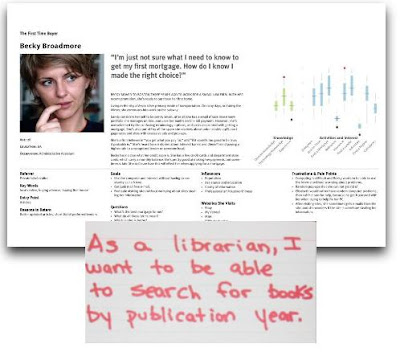In this process I complemented a few standard research methods, such as demographic personas, with a more activity based approach, which also contained high level flow charts. These high level user descriptions in turn can support a variety of scenario descriptions, user requirement documents, and also help to integrate UCD methods in the context of agile development.
PLC covers a number of different law disciplines, such as financial, tax, commercial, property, aimed at different supporting lawyers as well as senior staff and partners. The user group of “laywers” is, therefore, a very wide matrix. As part of this work, it was crucial to understand that lawyers working in different fields work in very different ways. PLC produces digests from the latest legal publications, helping busy lawyers update themselves on the latest situations with speed and ease.
This sounds like a functional, rational, highly structured field, where functionality is key. In fact, this was very affective-specific work – lawyers are a highly individual user group. They have to get their facts right, or they can be sued (both privately and as a firm). Winning a case depends on them having the correct up-to-date knowledge.
Having confidence in a digest, such as those produced by the PLC, means an enormous amount of trust and previous research: lawyers double-check PLC’s publications to ensure that they are trustworthy.
Imagine a lawyer going about his work: jumping into a cab, reading PLC information on a Blackberry, and then heading straight into a court-room. We named this key emotional branding moment: the PLC moment. This is the moment when a lawyer trusts the publication material implicitly. This ties in with my research thesis that structural, functional and unstructured, emotional interaction are highly intertwined – and this has never been truer than at PLC.
Position: Senior UXA
Year: 2009 / 2010
PLC covers a number of different law disciplines, such as financial, tax, commercial, property, aimed at different supporting lawyers as well as senior staff and partners. The user group of “laywers” is, therefore, a very wide matrix. As part of this work, it was crucial to understand that lawyers working in different fields work in very different ways. PLC produces digests from the latest legal publications, helping busy lawyers update themselves on the latest situations with speed and ease.
This sounds like a functional, rational, highly structured field, where functionality is key. In fact, this was very affective-specific work – lawyers are a highly individual user group. They have to get their facts right, or they can be sued (both privately and as a firm). Winning a case depends on them having the correct up-to-date knowledge.
Having confidence in a digest, such as those produced by the PLC, means an enormous amount of trust and previous research: lawyers double-check PLC’s publications to ensure that they are trustworthy.
Imagine a lawyer going about his work: jumping into a cab, reading PLC information on a Blackberry, and then heading straight into a court-room. We named this key emotional branding moment: the PLC moment. This is the moment when a lawyer trusts the publication material implicitly. This ties in with my research thesis that structural, functional and unstructured, emotional interaction are highly intertwined – and this has never been truer than at PLC.
Position: Senior UXA
Year: 2009 / 2010

